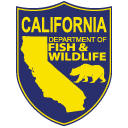
CDFW photo by L. Slatoff
Along Highway 1 nestled between the cities of San Simeon and Cambria in San Luis Obispo County is a 5.8 mile stretch of beautiful coastline and the Cambria State Marine Conservation Area (SMCA).

CDFW map by Marine Region GIS Lab
Regulations for Cambria SMCA, and its neighbor to the south, White Rock SMCA, were adopted by the Fish and Game Commission in 2006 and went into effect in 2007 as part of the first regional implementation phase of the Marine Life Protection Act (MLPA). Passed in 1999, the MLPA mandated California create a science-based ecologically connected network of marine protected areas (MPAs). While recreational take is allowed, commercial take is prohibited in this MPA. Cambria SMCA is also nestled within the larger federally managed Monterey Bay National Marine Sanctuary which was implemented in 1992.
Cambria SMCA was created with the intent to help sustain nearshore rockfish, cabezon, and kelp greenling populations and the habitat on which they depend, while enhancing recreational opportunities. Rockfish are the most common fish species. They range from the rocky intertidal zone to water depths of 3,000 meters (9,800 feet), well beyond the reach of recreational anglers. Rockfish are “homebodies” meaning that they have high site fidelity, so they tend to stay in certain areas their entire lives. Rockfish come in a wide variety of colors and patterns from dark green to red and white striped. They are part of the family Scorpaenidae which have venomous spines on their dorsal fins. Though rockfish are only slightly toxic, be careful when handling them.
If you prefer to just watch animals instead of catching them, Cambria SMCA is the perfect place for wildlife viewing, particularly marine mammals. Humpback and gray whales pass this area in the fall as they head to their breeding grounds offshore of Mexico and Central America. Then in the spring the mothers and their calves can be seen migrating north to their summer foraging sites in British Columbia, Canada, and the Bering Sea, respectively. If you are visiting during the winter, you can see elephant seals on this beach. These large seals will rest and defend their beach territory until they return to the ocean in March. There are other marine mammals like sea otters and harbor seals that are present all year round.
Just north from this beach is the road to Hearst Castle. This California landmark was the luxurious home of William Randolph Hearst, a newspaper and media magnate in the late 1800s. As you drive along Highway 1, you might be lucky enough to see the wild zebras that live on the property. They were bought by Hearst for his private zoo and were released to roam the hillsides of the property after his death. The population has thrived in this area and are a popular roadside attraction on sunny days.

CDFW photo by L. Slatoff
If wildlife viewing doesn’t suit you, then you can go rockhounding or beachcombing at the aptly named Moonstone Beach. The beach gets its name from the quartz that resembles moonstones and can be found mixed in with the sand. Though they may not be true gemstones as the beach’s name may indicate, they are beautiful, and collecting them is an easy activity for the whole family. You can also enjoy a nice walk along the boardwalk just above the beach.
Whether you like wildlife viewing, rock collecting, or relaxing at the beach, there is something for everyone to enjoy in Cambria SMCA and its surroundings.
*In August 2010, the State Parks Commission voted to designate Cambria SMCA as a State Marine Park (SMP). No changes were made to the existing boundaries and take regulations as adopted by the California Fish and Game Commission.
Cambria State Marine Conservation Area is one of 124 MPAs in California’s statewide MPA network. Please visit CDFW’s MPA website for more information and sign up to receive updates about the MPA Management Program.
 post by Lara Slatoff, CDFW Environmental Scientist
post by Lara Slatoff, CDFW Environmental Scientist
Learn more about MPAs by diving into the
Exploring California’s Marine Protected Areas series!



